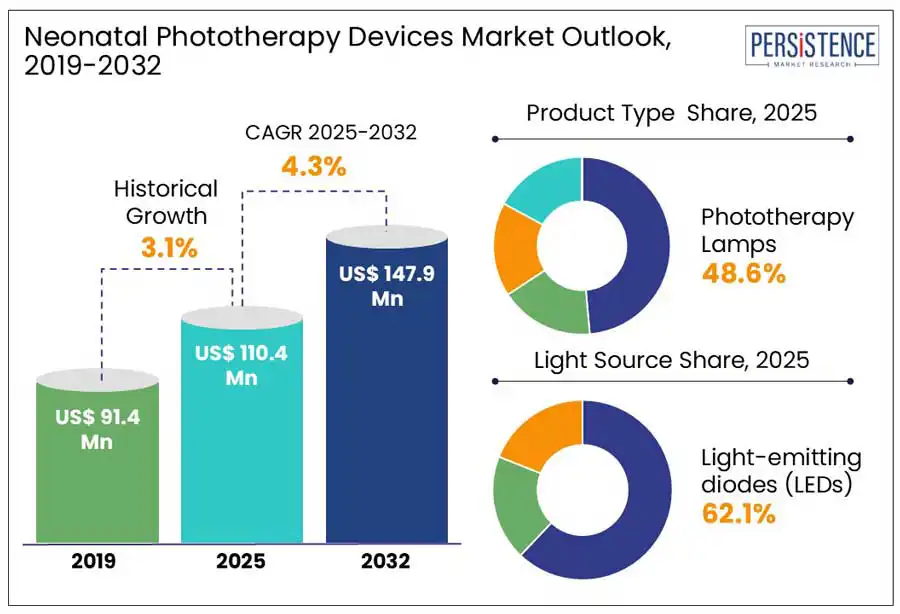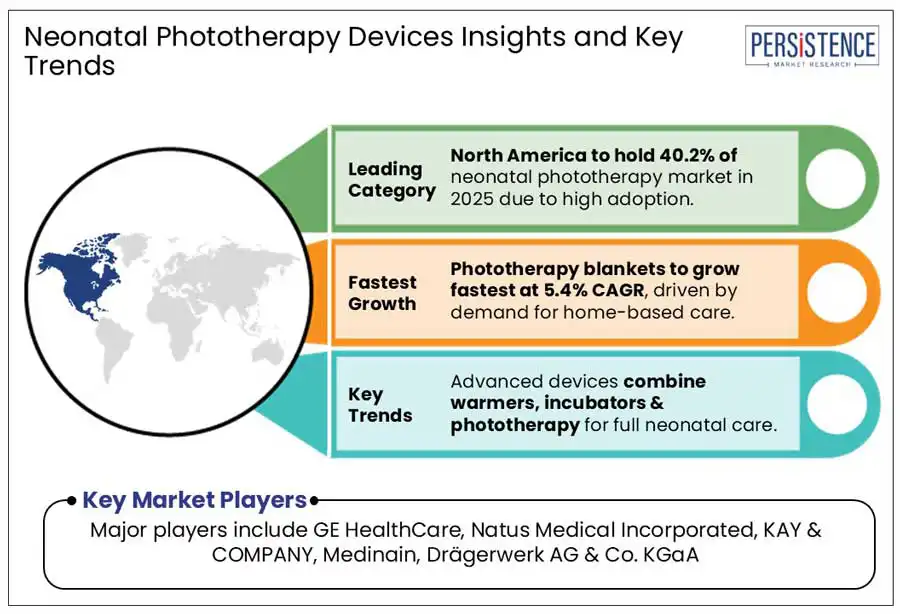Comprehensive Analysis of Neonatal Phototherapy Devices Including Regional and Country Analysis in Brief.
Industry: Healthcare
Published Date: April-2025
Format: PPT*, PDF, EXCEL
Delivery Timelines: Contact Sales
Number of Pages: 180
Report ID: PMRREP35192
The global neonatal phototherapy devices market size is anticipated to value at US$ 110.4 Mn in 2025 to reach US$ 147.9 Mn with a CAGR of 4.3% by 2032. The increasing incidences of jaundice in newborns is driving demand for advanced phototherapy devices to prevent severe complications such as kernicterus and neurodevelopmental disorders, says Persistence Market Research Report.
Companies such as GE Healthcare, Philips, and NeoLight are developing energy-efficient, portable, and non-invasive phototherapy solutions, addressing concerns about safety, affordability, and hospital-acquired infections. Additionally, government and NGO initiatives promoting neonatal healthcare infrastructure is fueling market growth, particularly in developing regions such as Asia Pacific and Africa. As healthcare systems prioritize cost-effective and advanced neonatal care solutions, the demand for compact, wearable, and AI-integrated phototherapy devices is expected to accelerate, shaping the future of neonatal jaundice treatment.

Key Industry Highlights:
|
Global Market Attribute |
Key Insights |
|
Neonatal Phototherapy Devices Market Size (2025E) |
US$ 110.4 Mn |
|
Market Value Forecast (2032F) |
US$ 147.9 Mn |
|
Projected Growth (CAGR 2025 to 2032) |
4.3% |
|
Historical Market Growth (CAGR 2019 to 2024) |
3.1% |
The increasing prevalence of neonatal jaundice, especially in preterm and low-birth-weight infants, is fueling the demand for effective phototherapy solutions. The shift from fluorescent to LED phototherapy devices has enhanced treatment efficiency, reduced heat production, and lowered energy consumption. Devices such as Natus neoBLUE LED and GE Healthcare’s Lullaby LED provide high-intensity, uniform light therapy for faster bilirubin breakdown. Additionally, hybrid phototherapy-incubator systems, such as Atom Medical’s Dual Incu i and D-Rev’s Brilliance Pro, integrate temperature regulation and cost-effective LED technology, improving care accessibility. With rising healthcare investments and government initiatives, advanced phototherapy adoption is poised to expand globally, ensuring better treatment outcomes and neonatal health.
Limited access to modern neonatal care facilities in rural and underdeveloped areas remains a significant restraint. In many low-income regions, healthcare infrastructure is inadequate, with a shortage of well-equipped NICUs and trained medical professionals to manage neonatal jaundice effectively. Additionally, a lack of awareness about the importance of early jaundice detection and treatment leads to delayed interventions, increasing the risk of complications such as kernicterus and long-term neurological damage.
Countries with high neonatal mortality rates often face challenges in procuring and maintaining advanced phototherapy devices, further limiting treatment accessibility. Without sustained government initiatives and international support, bridging this healthcare gap remains a major challenge, restricting the adoption of neonatal phototherapy solutions in resource-limited settings.
Governments in high-birth-rate countries are increasingly investing in neonatal healthcare infrastructure, creating significant opportunities for the market. Programs like India’s National Health Mission (NHM) and Brazil’s Rede Cegonha (Stork Network) are expanding NICU facilities, improving healthcare personnel training, and enhancing access to quality neonatal care. Additionally, initiatives such as the U.S. Commonwealth Fund’s maternal-infant health partnerships demonstrate how government-backed collaborations are strengthening neonatal healthcare systems. These investments drive the demand for advanced neonatal care solutions, including phototherapy devices for treating neonatal jaundice, as improved healthcare infrastructure ensures wider adoption and accessibility in both urban and rural healthcare settings.
Phototherapy lamps are expected to dominate accounting for approximately 48.6% share in 2025. Their widespread use in hospitals and NICUs, high-intensity light output, and effectiveness in reducing bilirubin levels quickly contribute to their strong market position. Traditional phototherapy setups with fluorescent or LED lamps are preferred in clinical settings due to their reliable treatment outcomes and established protocols. For instance, GE Healthcare’s Lullaby LED Phototherapy System provides high-intensity blue light for efficient bilirubin breakdown, ensuring faster recovery for affected newborns.
Light-emitting diodes (LEDs) are expected to account for a share of 62.1% in 2025. The adoption of advanced LED phototherapy devices is increasing due to their superior efficacy, energy efficiency, and ability to provide precise bilirubin reduction in neonatal jaundice management. For example, Atom Medical’s Bili-Therapy Spot Type and Draeger’s BiliLux LED Phototherapy systems provide targeted, high-intensity blue light with adjustable intensity settings, enhancing treatment outcomes while minimizing energy consumption.
Neonatal jaundice management is expected to capture a lion’s share of 83.2%, in 2025. This dominance is driven by the high global prevalence of neonatal jaundice, which affects nearly 60% of full-term and 80% of preterm newborns, according to a recent study published by NIH. Effective phototherapy treatment is essential in preventing complications such as kernicterus and neurological damage, making it the primary application for these devices. In the near future, the skin disease treatment segment is expected to rise, driven by increasing research on phototherapy for neonatal skin conditions such as infantile hemangiomas and eczema.

North America is projected to dominate 40.2% of the global market by 2025, driven by advanced neonatal care infrastructure and strong industry collaborations. Companies like NeoLight are expanding their neonatal care portfolio through strategic partnerships, such as its exclusive U.S. distribution agreement with ANT Neuro for the nëo CFM system and its collaboration with Florida State University on non-nutritive sucking technology. Additionally, the region’s high adoption of advanced LED phototherapy and hybrid incubator systems, along with favorable healthcare policies and investments, further strengthens its market leadership.
East Asia is expected to reach 18.3% in 2025. The growing accessibility of neonatal phototherapy devices in Asia is driving market expansion, supported by technological advancements and improved healthcare infrastructure. According to recent studies, Japan’s development of wearable jaundice monitoring devices showcases the region’s innovation in neonatal care, enabling more effective and less disruptive treatment.
Additionally, GE Healthcare’s expansion of its e-commerce platform across multiple Asia Pacific countries enhances access to quality neonatal phototherapy solutions, particularly in developing markets such as Thailand, Malaysia, and the Philippines. This increasing availability of advanced and affordable phototherapy devices is significantly improving neonatal healthcare outcomes across the region.
The Neonatal Phototherapy Devices market is highly competitive, with key players such as GE Healthcare, Natus Medical, Atom Medical, and Draegerwerk AG driving innovation. Advanced LED phototherapy devices, hybrid incubator-phototherapy systems, and portable solutions such as Natus neoBLUE LED and Atom Medical’s Dual Incu i enhance treatment efficiency. Affordable options like D-Rev’s Brilliance Pro improve accessibility in low-resource settings, fueling market growth.
|
Report Attribute |
Details |
|
Historical Data/Actuals |
2019 - 2024 |
|
Forecast Period |
2025 - 2032 |
|
Market Analysis Units |
Value: US$ Mn Volume: As Applicable |
|
Geographical Coverage |
|
|
Segmental Coverage |
|
|
Competitive Analysis |
|
|
Report Highlights |
|
|
Customization and Pricing |
Available upon request |
By Product Type
By Light Source
By Configuration
By Application
By End-user
By Region
To know more about delivery timeline for this report Contact Sales

The global Neonatal Phototherapy Devices market is estimated to increase from US$ 110.4 Mn in 2025 to US$ 147.9 Mn in 2032.
The global neonatal phototherapy devices market is driven by the growing incidence of neonatal jaundice, a rising number of preterm births, and continuous advancements in LED phototherapy technology.
The market is projected to record a CAGR of 4.3% during the forecast period from 2025 to 2032.
Major players include GE HealthCare, Natus Medical Incorporated, KAY & COMPANY, Inc, Ibis Medical, and Drägerwerk AG & Co. KGaA, among others.
One significant opportunity in the neonatal phototherapy devices market is the growing demand for portable and home-use phototherapy devices, enabling jaundice treatment outside hospital settings, particularly in low-resource regions and remote areas where the access to NICU is limited.